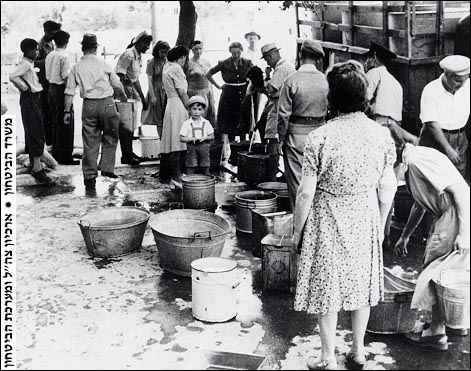 In 1947 100,000 Jews lived in Jerusalem and 65,000 Arabs. The city was surrounded by Arab settlements that controlled all access roads from the east, north, and south. The only outlet from Jerusalem to the coastal area, controlled by the Jews, was through the narrow highway winding west in the mountains to Sha'ar haGay (Bab el-Wad), to Kibbutz Hulda, and from there to Tal-Aviv and the shore plane. The highway was controlled by Arab settlements whose inhabitants, and later troops of the Arab Legion, attacked Jewish transportation, especially from Bab el-Wad through the mountains to Jerusalem.
In 1947 100,000 Jews lived in Jerusalem and 65,000 Arabs. The city was surrounded by Arab settlements that controlled all access roads from the east, north, and south. The only outlet from Jerusalem to the coastal area, controlled by the Jews, was through the narrow highway winding west in the mountains to Sha'ar haGay (Bab el-Wad), to Kibbutz Hulda, and from there to Tal-Aviv and the shore plane. The highway was controlled by Arab settlements whose inhabitants, and later troops of the Arab Legion, attacked Jewish transportation, especially from Bab el-Wad through the mountains to Jerusalem.
Most Jewish population was concentrated in the western part of the city, and most Arabs in the west. Moreover, some Jewish enclaves were isolated within Arab neighborhoods, cut off from Jewish Jerusalem. Thus the Jewish Quarter in the heart of the Old City, the old commercial center west of the Old City, Beit HaKerem and Bait Va'Gan in the west, Mount Scopus in the north, Talpiot in the south, etc.
In addition, some other Jewish settlements outside Jerusalem were isolated within Arab areas: Neve Ya'Akov and Atarot in the north, Ramah Rachel in the south, Hartuv in the west and the Gush Etzion settlements, Sodom and the north part of the Dead Sea.
In March 1948, this lone artery was blocked, supplies, food, equipment, medical stuff and weapons and ammunitions could not reach the city – Jewish Jerusalem was besieged, attacked and shelled day and night.
To supply the civilian population, what little food and water remained were allocated by rationing. With time the distress aggravated and desperate calls for help increased.
In April, May, and June, several military operations were planned and carried out around the road to Jerusalem to break the siege and link Jerusalem to the coastal area. (Nahshon, Harel, Maccabee, Bin-Nun, Yoram). Arab strongpoints were seized and the Arab control of the road was removed.
Meanwhile, in June, in mid warfare, an alternative route, The Burma Road, was prepared, through which food and supply convoys reached Jerusalem. Thus, in July, the siege was partially lifted after seven weeks.
Following the "Ten Day Battles" (9 – 18 July, 1948), during which more territories were seized and the corridor to Jerusalem was broadened, a more suitable road was paved to Jerusalem ("Kvish Ha'Gvura")
(The story of the convoys to Jerusalem is presented in a separate exhibition).